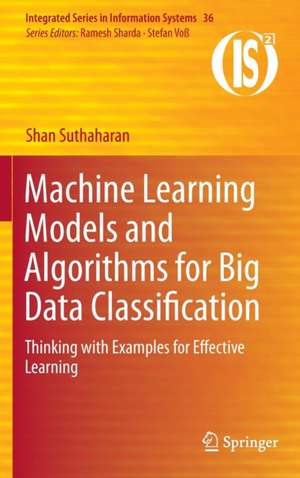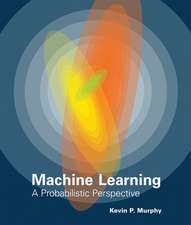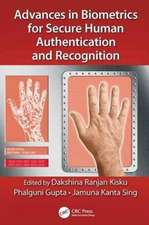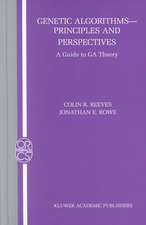Machine Learning Models and Algorithms for Big Data Classification: Thinking with Examples for Effective Learning: Integrated Series in Information Systems, cartea 36
Autor Shan Suthaharanen Limba Engleză Hardback – 21 oct 2015
The presentation format of this book focuses on simplicity, readability, and dependability so that both undergraduate and graduate students as well as new researchers, developers, and practitioners in this field can easily trust and grasp the concepts, and learn them effectively. It has been written to reduce the mathematical complexity and help the vast majority of readers to understand the topics and get interested in the field. This book consists of four parts, with the total of 14 chapters. The first part mainly focuses on the topics that are needed to help analyze and understand data and big data. The second part covers the topics that can explain the systems required for processing big data. The third part presents the topics required to understand and select machine learning techniques to classify big data. Finally, the fourth part concentrates on the topics that explain the scaling-up machine learning, an important solution for modern big data problems.
| Toate formatele și edițiile | Preț | Express |
|---|---|---|
| Paperback (1) | 948.47 lei 6-8 săpt. | |
| Springer Us – 23 aug 2016 | 948.47 lei 6-8 săpt. | |
| Hardback (1) | 954.62 lei 6-8 săpt. | |
| Springer Us – 21 oct 2015 | 954.62 lei 6-8 săpt. |
Din seria Integrated Series in Information Systems
- 15%
 Preț: 646.62 lei
Preț: 646.62 lei - 20%
 Preț: 996.07 lei
Preț: 996.07 lei - 20%
 Preț: 1272.94 lei
Preț: 1272.94 lei -
 Preț: 389.11 lei
Preț: 389.11 lei - 20%
 Preț: 998.04 lei
Preț: 998.04 lei - 15%
 Preț: 654.43 lei
Preț: 654.43 lei - 20%
 Preț: 1933.71 lei
Preț: 1933.71 lei -
 Preț: 388.52 lei
Preț: 388.52 lei - 15%
 Preț: 646.11 lei
Preț: 646.11 lei - 15%
 Preț: 667.71 lei
Preț: 667.71 lei - 15%
 Preț: 711.89 lei
Preț: 711.89 lei -
 Preț: 393.52 lei
Preț: 393.52 lei - 15%
 Preț: 644.82 lei
Preț: 644.82 lei - 18%
 Preț: 955.25 lei
Preț: 955.25 lei - 5%
 Preț: 1280.25 lei
Preț: 1280.25 lei - 15%
 Preț: 586.55 lei
Preț: 586.55 lei - 15%
 Preț: 638.11 lei
Preț: 638.11 lei - 20%
 Preț: 1277.24 lei
Preț: 1277.24 lei - 20%
 Preț: 1215.12 lei
Preț: 1215.12 lei - 20%
 Preț: 638.37 lei
Preț: 638.37 lei - 5%
 Preț: 1801.57 lei
Preț: 1801.57 lei - 18%
 Preț: 952.72 lei
Preț: 952.72 lei - 15%
 Preț: 653.14 lei
Preț: 653.14 lei - 20%
 Preț: 995.75 lei
Preț: 995.75 lei - 20%
 Preț: 649.28 lei
Preț: 649.28 lei
Preț: 954.62 lei
Preț vechi: 1164.17 lei
-18% Nou
Puncte Express: 1432
Preț estimativ în valută:
182.67€ • 188.45$ • 152.44£
182.67€ • 188.45$ • 152.44£
Carte tipărită la comandă
Livrare economică 27 martie-10 aprilie
Preluare comenzi: 021 569.72.76
Specificații
ISBN-13: 9781489976406
ISBN-10: 148997640X
Pagini: 359
Ilustrații: XIX, 359 p. 149 illus., 82 illus. in color.
Dimensiuni: 155 x 235 x 27 mm
Greutate: 0.71 kg
Ediția:1st ed. 2016
Editura: Springer Us
Colecția Springer
Seria Integrated Series in Information Systems
Locul publicării:New York, NY, United States
ISBN-10: 148997640X
Pagini: 359
Ilustrații: XIX, 359 p. 149 illus., 82 illus. in color.
Dimensiuni: 155 x 235 x 27 mm
Greutate: 0.71 kg
Ediția:1st ed. 2016
Editura: Springer Us
Colecția Springer
Seria Integrated Series in Information Systems
Locul publicării:New York, NY, United States
Public țintă
ResearchCuprins
Science of Information.- Part I Understanding Big Data.- Big Data Essentials.- Big Data Analytics.- Part II Understanding Big Data Systems.- Distributed File System.- MapReduce Programming Platform.- Part III Understanding Machine Learning.- Modeling and Algorithms.- Supervised Learning Models.- Supervised Learning Algorithms.- Support Vector Machine.- Decision Tree Learning.- Part IV Understanding Scaling-Up Machine Learning.- Random Forest Learning.- Deep Learning Models.- Chandelier Decision Tree.- Dimensionality Reduction.
Recenzii
“It provides a readable, technical, description of the whole area of machine learning applied on big data that can be understood and enjoyed by students and researchers from many areas of computer science, statistics, biology and chemistry who are seeking to understand how these new technologies can benefit their special areas. … Overall, this is an excellent introduction to the main ideas for using machine learning algorithms for big data classification.” (Smaranda Belciug, zbMATH 1409.68004, 2019)
“This book is a good introduction to machine learning models for big data classification … . Typical of a Springer book, this one is concise,clear, and well organized. … each chapter contains programming examples and references … . this book is useful if you want to know more about machine learning models and algorithms for big data classification.” (J. Myerson, Computing Reviews, February, 2016)
“This book is a good introduction to machine learning models for big data classification … . Typical of a Springer book, this one is concise,clear, and well organized. … each chapter contains programming examples and references … . this book is useful if you want to know more about machine learning models and algorithms for big data classification.” (J. Myerson, Computing Reviews, February, 2016)
Notă biografică
Shan Suthaharan is a Professor of Computer Science at the University of North Carolina at Greensboro (UNCG), North Carolina, USA. He also serves as the Director of Undergraduate Studies at the Department of Computer Science at UNCG. He has more than twenty-five years of university teaching and administrative experience, and has taught both undergraduate and graduate courses. His aspiration is to educate and train students so that they can prosper in the computer field by understanding current real-world and complex problems, and develop efficient techniques and technologies. His current teaching interests include big data analytics and machine learning, cryptography and network security, and computer networking and analysis. He earned his doctorate in Computer Science from Monash University, Australia. Since then, he has been actively working on disseminating his knowledge and experience through teaching, advising, seminars, research, and publications. Dr. Suthaharan enjoys investigating real-world, complex problems, and developing and implementing algorithms to solve those problems using modern technologies. The main theme of his current research is the signature discovery and event detection for a secure and reliable environment. The ultimate goal of his research is to build a secure and reliable environment using modern and emerging technologies. His current research primarily focuses on the characterization and detection of environmental events, the exploration of machine learning techniques, and the development of advanced statistical and computational techniques to discover key signatures and detect emerging events from structured and unstructured big data. Dr. Suthaharan has authored or co-authored more than seventy-five research papers in the areas of computer science, and published them in international journals and referred conference proceedings. He also invented a key management and encryption technology, which has been patented in Australia, Japan, and Singapore. He also received visiting scholar awards from and served as a visiting researcher at the University of Sydney, Australia; the University of Melbourne, Australia; and the University of California, Berkeley, USA. He was a senior member of the Institute of Electrical and Electronics Engineers, and volunteered as an elected chair of the Central North Carolina Section twice. He is a member of Sigma Xi, the Scientific Research Society, and a Fellow of the Institution of Engineering and Technology.
Textul de pe ultima copertă
This book presents machine learning models and algorithms to address big data classification problems. Existing machine learning techniques like the decision tree (a hierarchical approach), random forest (an ensemble hierarchical approach), and deep learning (a layered approach) are highly suitable for the system that can handle such problems. This book helps readers, especially students and newcomers to the field of big data and machine learning, to gain a quick understanding of the techniques and technologies; therefore, the theory, examples, and programs (Matlab and R) presented in this book have been simplified, hardcoded, repeated, or spaced for improvements. They provide vehicles to test and understand the complicated concepts of various topics in the field. It is expected that the readers adopt these programs to experiment with the examples, and then modify or write their own programs toward advancing their knowledge for solving more complex and challenging problems.
The presentation format of this book focuses on simplicity, readability, and dependability so that both undergraduate and graduate students as well as new researchers, developers, and practitioners in this field can easily trust and grasp the concepts, and learn them effectively. It has been written to reduce the mathematical complexity and help the vast majority of readers to understand the topics and get interested in the field. This book consists of four parts, with the total of 14 chapters. The first part mainly focuses on the topics that are needed to help analyze and understand data and big data. The second part covers the topics that can explain the systems required for processing big data. The third part presents the topics required to understand and select machine learning techniques to classify big data. Finally, the fourth part concentrates on the topics that explain the scaling-up machine learning, an important solution for modern big data problems.
The presentation format of this book focuses on simplicity, readability, and dependability so that both undergraduate and graduate students as well as new researchers, developers, and practitioners in this field can easily trust and grasp the concepts, and learn them effectively. It has been written to reduce the mathematical complexity and help the vast majority of readers to understand the topics and get interested in the field. This book consists of four parts, with the total of 14 chapters. The first part mainly focuses on the topics that are needed to help analyze and understand data and big data. The second part covers the topics that can explain the systems required for processing big data. The third part presents the topics required to understand and select machine learning techniques to classify big data. Finally, the fourth part concentrates on the topics that explain the scaling-up machine learning, an important solution for modern big data problems.
Caracteristici
Addresses a new and hot field of Big Data Science and Engineering Offers new Machine Learning techniques and solutions Provides solutions to overcome Big Data classification problems that industries, government agencies and organizations struggle to manage and analyze Includes supplementary material: sn.pub/extras













